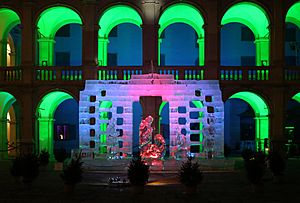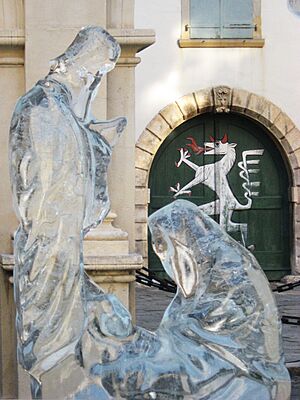Ice nativity scene (Graz) facts for kids
The ice nativity scene (called Eiskrippe in German) is a beautiful sculpture made of ice. You can see it every year in the Landhaus courtyard in Graz, Austria. It's displayed during the Advent season, which is the time leading up to Christmas.
This amazing nativity scene, carved from clear ice, has been a special part of Graz's Christmas celebrations since 1996. Lots of people from all over the world hear about it!
Contents
The Story of the Ice Nativity Scene
The very first ice nativity scene was created in 1996. The Graz tourist association asked for it to be made. They wanted something unique for the city's Christmas time.
The First Ice Artist
A famous ice artist named Gert J. Hödl (1943–2017) from Villach, Austria, led the project. He was already well-known for his ice art in places like Canada, Russia, Norway, and Japan.
After two years of planning, Hödl and his four helpers carved the first scene. They used 156 huge blocks of ice. The total weight was 23 tons! This was a world first, meaning it had never been done before.
The Landhaus in the city center was chosen as the perfect spot. The ice figures were life-sized. The whole artwork was eight meters wide and four meters high.
Annual Display and Changes
The tourist association kept this special project going every year. By 1998, you could even watch the carving live online!
Each year, the nativity scene is sculpted in late November or early December. It is then shown to the public in a special ceremony. In the evenings, colorful lights shine on the ice scene and the Landhaus arches.
To make the ice last longer, bigger blocks were used starting in 2003. That year, Graz was the European Capital of Culture. The ice weight grew to 45 tons. The ice also looked a bit green for the first time.
Special Tributes and Innovations
In 2003, Gert Hödl added a special touch. He put a bear behind the Holy family in the scene. This was a tribute to Arnold Schwarzenegger, who was born in Graz. Schwarzenegger had just become the Governor of California. The bear is California's official animal. This made the ice nativity scene even more famous around the world!
Other ideas were tried to slow down the melting. In 2004, a more "monumental construction" was used. This was meant to create an "ice house effect." This helps keep the ice cool. Extra sets of ice figures are kept in an ice house near Graz. They are ready to be used if any parts of the main scene melt too much.
New Artistic Leadership
Since 2014, a Finnish ice artist named Kimmo Frosti has been in charge. He designs the ice nativity scene each year. With help from a five-person team and liquid nitrogen, it takes him about a week to finish the work. A forklift is then used to carefully put all the ice parts together.
The ice nativity scene has gained international attention since it first started. By 2016, over 200 TV channels and newspapers worldwide had reported on it. News groups like The Huffington Post and Reuters also shared its story.
Artistic Directors
See also
 In Spanish: Belén de hielo para niños
In Spanish: Belén de hielo para niños



